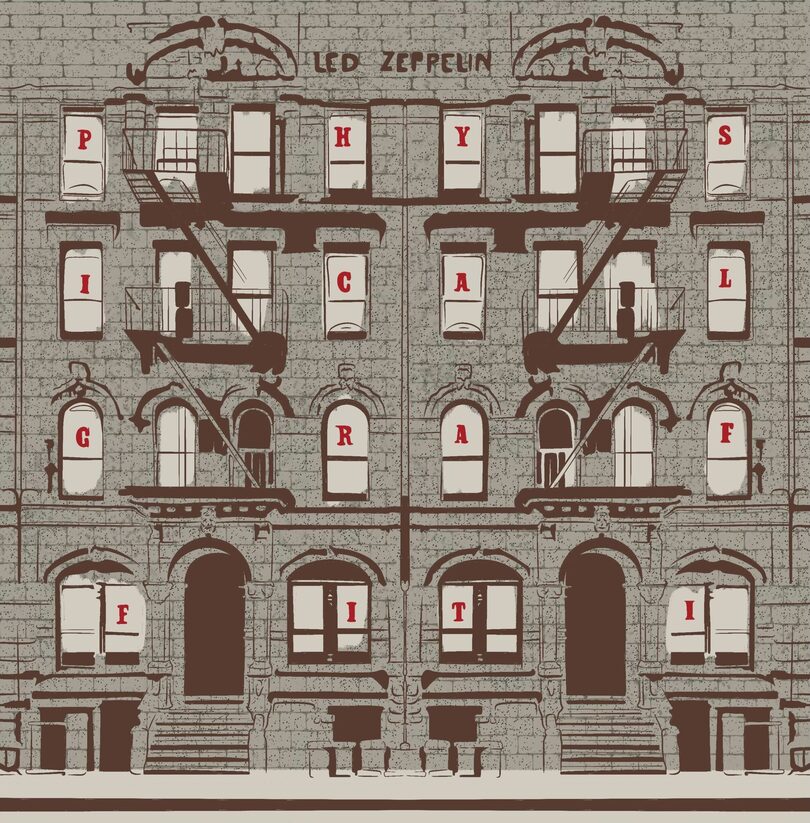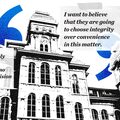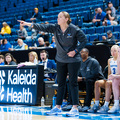Led Zeppelin salutes 50 years of ‘Physical Graffiti’ with new live EP

The album cover of “Physical Graffiti” is based off a busy apartment building in New York City. The original cover’s interactive design was so complicated that it delayed the album’s release to the next year. Emma Soto | Contributing Illustrator
Get the latest Syracuse news delivered right to your inbox.
Subscribe to our newsletter here.
Actor and musician Jack Black once said the only way to explain Led Zeppelin’s ungodly talents was that they must’ve sold their souls to Satan.
Friday marked the 50th anniversary of Led Zeppelin’s album, “Physical Graffiti,” celebrated with the release of a new EP titled “Live EP.” It features four previously unreleased live recordings.
Bands like Aerosmith, The Rolling Stones and Black Sabbath defined the 1970s, a period often described as a renaissance of music hailed for its creativity and complex musicianship. But when you hear the term classic rock, there’s truly only one band that comes to mind: Led Zeppelin.
The original double LP is overlooked alongside the rest of their discography, ranking outside the band’s top five works in record sales.
So why is this album any more special than the rest?
Albert Einstein once said, “Creativity is seeing what others see and thinking what no one else ever thought.” While Einstein couldn’t shred like lead guitarist Jimmy Page, his sentiment parallels the essence of the band.
The group was coined as different by fans and critics alike, making music that some adored and others hated. Each of their first five albums sounded distinct, with new themes emerging on each vinyl. From the psychedelic rollercoaster of “Dazed and Confused” off their debut album to the obscure tuning and melancholic tone of “The Rain Song,” Led Zeppelin never stopped evolving.
“Physical Graffiti” was no different.
Page produced the record, and it was primarily recorded at Headley Grange, a former food-shelter-turned-recording-spot for the band. Led Zeppelin created eight new songs for the album, while the rest were unused tracks from albums like “Led Zeppelin IV” and “Houses of the Holy.”
The album’s cover art is multifaceted. The building on the front was drawn from New York City’s East Village. It was inspired by tenants constantly moving in and out of the building, with different inserts sliding into the vinyl to create unique combinations. The idea was so complex to execute that it ended up delaying the record’s release to the following year in 1975.
The album is filled with classics. “The Rover” is a Led Zeppelin tune with fiery chemistry between Page and drummer John Bonham. The two groove throughout, tossing fills and solos back and forth. The song is still seen as one of Led Zeppelin’s most underrated tracks.
Another standout, “Bron-Yr-Aur,” offers a much more acoustic sound. Many Led Zeppelin songs feature lead singer Robert Plant’s soaring vocals, but this track features an intimate instrumental inspired by his family cottage, where many of the band’s tracks were arranged.
Its title translates to “hill of gold” in Welsh. The soothing yet intricate plucking moves listeners into a calming lull, reminiscent of childhood.
Lastly — and my personal favorite — is “Ten Years Gone,” which lures listeners into a hypnotic state. The song evolves throughout, cultivating a classic Page feel accompanied by Plant’s dark lyrics. An epic in its truest form, the song represents the heart of the album.

Sophia Burke | Digital Design Director
But Led Zeppelin’s success wasn’t just in the studio. On stage, the songs from the album took on a new life. “Live EP” contains four different songs and performances from the original album.
The opening track, “In My Time of Dying” live from Earl’s Court in 1975, sounds mesmerizing. The song exudes creativity with bassist John Paul Jones using a fretless bass for more control over the pitch and tone. Bonham’s sound is in full swing, using a reverb effect to both loosen the kit and strengthen its atmosphere.
Also at Earl’s Court, the band delivered an almost 9-minute-long performance of “Trampled Under Foot.” The song is imbued with funk, carried by a groovy riff from Page. Jones layered over a clavinet, an instrument created in 1964, intended to mimic the sound of an electric guitar. Combined with Page’s wah-wah pedal, it produced a vibe like no other in their collection.
In most Zeppelin songs, the band uses their instruments together for a certain sound, but this track is different. Each member of the band has their own style, making for a fun, energy-filled experience that ignites each member of the band.
The EP then flips, and the location changes to Knebworth in 1979 with a performance of the original album’s closing track, “Sick Again.” The driving guitar from Page, contrasted with depressing lyrics from Plant, creates a divisive feeling.
“Clutching pages from your teenage dream / In the lobby of the Hotel Paradise / Through the circus of the L.A. queens / How fast you’ll learn the downhill slide,” Plant says.
Plant explains how confusing it is to meet your childhood heroes. The lyrics are a vessel for the singular experience and misguided perspective of musicians.
The EP closes with the most popular song off the album, “Kashmir.” While all four members shine, Page reaches a new level, delivering one of the most iconic riffs in rock history.
The riff pushes the song along an ominous yet space-like voyage. It’s inspired by Plant’s drive through a desolate desert in Morocco. Driving with Page, the two saw the endless sand stretching in every direction and started to shape it into a song.
Like most Zeppelin songs, it only took three components to become a hit: Page, Bonham and Headley Grange. The two came together, and by the end of the night, the foundation for “Kashmir” was in place.
The live performance is thunderous. Off-beat switches between Bonham and Page pull listeners into a trance. The song reaches an explosive finale, with Page firing off an incessant solo and Bonham’s booming fills. It’s the perfect end to “Live EP” that exemplifies Zeppelin’s sound.
Fifty years later, “Physical Graffiti” shows why Zeppelin remains a benchmark of creativity and reinvention. The band’s live performances still sound as powerful and timeless as they did in 1975, continuing to inspire musicians and fans alike.






